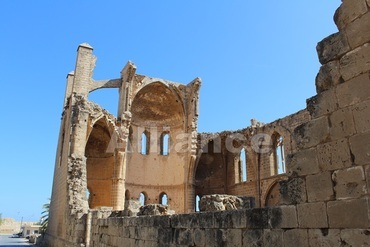Cyprus was one of the first places, converted to Christianity, and as part of the Byzantine Empire, the population of Cyprus exercised Orthodoxy, as one of the main Christian denominations. There were some major doctrinal differences between Orthodoxy with center in Constantinople, and Latin Christianity centered in Rome. Two churches began to drift apart quite early due to cultural and linguistic differences. When Lusignans (which of course were French Catholics) took power of the island in their own hands in 1191, they inherited the island together with its Orthodox religion. They dramatically diminished the power of the Orthodox Church, by reducing the number of bishops from 14 to 4, giving control over it in the hands of the bishop of the Catholic Church of the island. In those days religious people lived in different areas of Famagusta, and the Greek dominated the south-eastern region. St. George’s church is the second largest in town and served the entire Greek Orthodox community.
Construction of the church dates back to the year of 1300, around the same time when Latin were building Cathedral of St. Nicholas (now Lala Mustafa Pasha Mosque). Pay attention to the columns, and you will see that they were originally much thinner. Their original size was not enough to support the weight of the roof, and the building began to crack. In order to save the church, architects faced the need to add special "collars" in order to support the weight of the building.
to the year of 1300, around the same time when Latin were building Cathedral of St. Nicholas (now Lala Mustafa Pasha Mosque). Pay attention to the columns, and you will see that they were originally much thinner. Their original size was not enough to support the weight of the roof, and the building began to crack. In order to save the church, architects faced the need to add special "collars" in order to support the weight of the building.
Apse was filled with colorful frescoes, some of which can be seen today. The image of Christ was painted on the dome and the picture of the crucifixion can still be noticeable today. The bullet holes, result of defense of the church are visible in the apse. In the 18th century, walled city of Famagusta was virtually abandoned, and only few residents lived in adobe houses. Sailors from the nearby port landed on shore and went into the city, chiseling pictures of ships on the walls of abandoned churches. If you look closely, you can see all that remains of the once vibrant drawings of ships on the walls of St. George. Strolling along the walls of the temple, you can see several arched niches that have been patrons of the tombs of the church.
During the siege of the city of the Ottoman Empire in the years 1570 -1571, the Church, as one of the city's attractions, towered over the city walls. It was a tempting target for attackers, and damage made by guns in the bombardment of the city, is still visible. Look carefully and you will see that some of the cannonballs are still in the walls of the church.

 to the year of 1300, around the same time when Latin were building Cathedral of St. Nicholas (now Lala Mustafa Pasha Mosque). Pay attention to the columns, and you will see that they were originally much thinner. Their original size was not enough to support the weight of the roof, and the building began to crack. In order to save the church, architects faced the need to add special "collars" in order to support the weight of the building.
to the year of 1300, around the same time when Latin were building Cathedral of St. Nicholas (now Lala Mustafa Pasha Mosque). Pay attention to the columns, and you will see that they were originally much thinner. Their original size was not enough to support the weight of the roof, and the building began to crack. In order to save the church, architects faced the need to add special "collars" in order to support the weight of the building.
